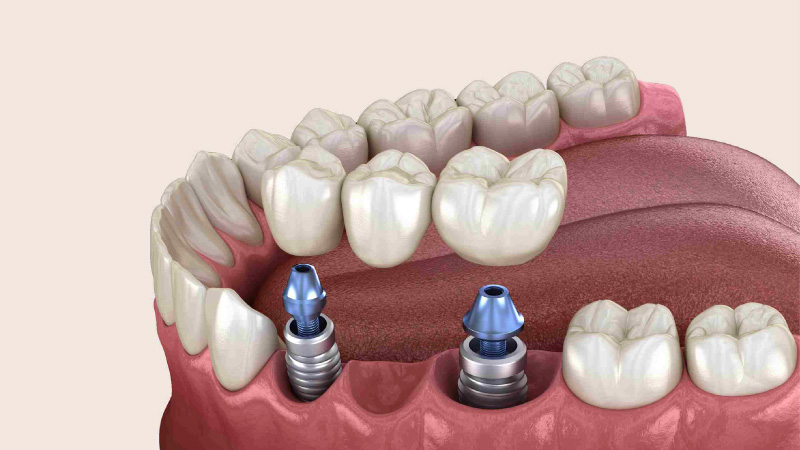Tooth loss can affect more than just your appearance—it can impact your ability to eat, speak, and feel confident. In the United States, millions of adults suffer from missing teeth due to decay, injury, or gum disease. According to the American College of Prosthodontists, over 120 million Americans are missing at least one tooth, and around 36 million have no natural teeth left. Fortunately, dental implants have become one of the most effective and long-lasting solutions to restore both function and confidence.

This article explains what dental implants are, how they work, their benefits, costs, and what you should consider before choosing this treatment.
What Are Dental Implants?
A dental implant is a small titanium post that is surgically placed into the jawbone to replace the root of a missing tooth. Once it heals, a custom-made crown, bridge, or denture is attached to the implant. Together, they look, feel, and function just like natural teeth.
Dental implants are considered a permanent solution because the titanium post fuses with your jawbone in a process called osseointegration. This not only secures the implant but also helps preserve bone health—something that traditional dentures or bridges cannot do.
Who Needs Dental Implants?
You might be a good candidate for dental implants if you:
- Have one or more missing teeth
- Have healthy gums and sufficient bone structure
- Don’t want removable dentures
- Are looking for a long-term, natural-looking solution
Implants can replace a single tooth, multiple teeth, or even a full set of teeth (known as All-on-4 implants).
The Dental Implant Procedure: Step-by-Step
- Consultation and Assessment
A dentist or oral surgeon will examine your mouth, take X-rays or 3D scans, and evaluate bone density. - Implant Placement
The titanium post is surgically inserted into your jawbone. You may receive local anesthesia or mild sedation for comfort. - Healing Period (Osseointegration)
Over the next 3–6 months, the implant fuses with your bone, creating a stable foundation for the new tooth. - Abutment and Crown Placement
Once healed, an abutment (connector) is attached, followed by a custom crown that matches the color and shape of your natural teeth.
The entire process may take several months, but the result is a durable and beautiful smile that can last a lifetime.
Benefits of Dental Implants
- Natural Look and Feel
Implants mimic the structure of natural teeth, making them indistinguishable from real ones in both appearance and function. - Long-Term Durability
With proper care, implants can last 20 years or more—far longer than bridges or dentures. - Bone Health Preservation
Implants stimulate the jawbone, preventing bone loss that typically occurs after tooth loss. - Improved Chewing and Speech
Unlike dentures, implants won’t slip or shift, allowing you to eat comfortably and speak clearly. - Confidence Boost
Many patients report improved self-esteem and quality of life after implant treatment.
How Much Do Dental Implants Cost in the U.S.?
The cost of dental implants varies depending on your location, the complexity of your case, and the materials used. Here’s a general breakdown:
| Implant Type | Average Cost (Per Tooth) |
|---|---|
| Single Tooth Implant | $3,000 – $4,500 |
| Implant-Supported Bridge | $5,000 – $15,000 |
| Full Mouth Implants (All-on-4) | $20,000 – $45,000 |
Some dental insurance plans may cover a portion of the cost, especially if tooth loss resulted from injury or medical necessity. It’s best to ask your provider for details.
How to Choose the Right Dental Implant Provider
When considering implants, don’t just look for the cheapest option—look for quality and expertise. Here are key factors to consider:
- Qualifications: Ensure your dentist or oral surgeon is certified and experienced in implant dentistry.
- Technology: Clinics using 3D imaging and guided surgery tend to provide more precise results.
- Material Quality: Ask about implant brands and crown materials; reputable systems like Straumann or Nobel Biocare are known for reliability.
- Reviews and Case Studies: Patient testimonials and before-and-after photos can help you gauge quality.
- Aftercare and Follow-up: Regular maintenance appointments ensure your implants stay healthy long-term.
Caring for Your Dental Implants
Good oral hygiene is essential for maintaining implants. Follow these steps:
- Brush twice daily with a soft-bristle toothbrush.
- Floss or use a water flosser to remove plaque around the implant.
- Schedule dental cleanings every six months.
- Avoid smoking, as it increases the risk of implant failure.
Foods That Support Healing and Long-Term Oral Health
After implant surgery—and even long after—you can support oral health with nutrient-rich foods:
- Soft proteins: Eggs, fish, and yogurt aid healing.
- Leafy greens: Spinach and kale provide calcium and vitamin K for bone health.
- Berries and citrus fruits: High in vitamin C to boost gum health.
- Whole grains: Contain magnesium, which helps maintain strong bone structure.
Avoid hard or sticky foods (like nuts, candies, or ice) immediately after surgery to prevent strain on the implant site.

Conclusion: Invest in Your Smile—and Your Health
Missing teeth can impact not just your appearance but your overall well-being. Dental implants offer a modern, effective, and long-lasting way to restore your smile and confidence. Though the cost may seem high initially, their durability and health benefits make them one of the best long-term investments in oral care.
If you’ve been living with missing teeth, now may be the time to talk to your dentist about whether dental implants are right for you. A confident smile isn’t just cosmetic—it’s a key part of living a healthy, fulfilling life.



